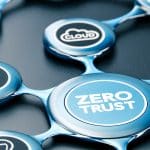Guardians of privacy: The promise of fully homomorphic encryption in the AI and blockchain era

The rise of AI has been nothing short of meteoric, especially with the advent of extensive language models like ChatGPT. We're witnessing a technological tide that might not only match, but even eclipse the transformative power of the internet. Every corner of our world, from the intricate complexities of finance to the foundational elements of education, is currently in the throes of a radical transformation catalyzed by artificial intelligence.
Yet, as we march forward in this brave new world of machine learning and digital cognition, there's an ever-looming shadow: the challenge of data privacy. Every digital query, every command we voice, and every interaction we have with these advanced systems invariably deposits bits of our personal information into vast databases. These repositories, managed by the service providers, become de facto vaults of our digital identities. The gravity of this concern hasn't been lost on the world's decision-makers. Countries not yet willing to take the blind leap have started sounding the alarm, and corporate behemoths have begun implementing restrictions on the use of such AI-driven tools.
Hiding undetected: Why security teams can no longer overlook HTTPS decryption

Decrypting HTTPS (TLS/SSL) traffic at the network perimeter is a vital step in protecting against malware and other online threats. Most of today’s web traffic is encrypted and presents an obvious hiding place for threat actors to deliver cyberattacks, since many network security controls aren’t set to inspect encrypted traffic. Consider recent findings from WatchGuard’s Threat Lab in its Q4 2022 Internet Security Report (ISR). While the report showed an apparent decline in overall malware volume, the Threat Lab analysts found a much higher prevalence of malware being delivered over encrypted connections when they looked closer at decrypted HTTPS traffic. These results came from a mere 20 percent of devices decrypting TLS and indicate the other 80 percent would also show malware volume is up, but hidden -- which mirrors findings from previous quarters.
Despite this trend, it’s common for teams not to enable decryption at the firewall due to the complications it can present. The process requires resources to decrypt and then re-encrypt traffic passing through a gateway device, as well as next-gen firewalls (NGFW) or unified threat management (UTM) appliances that use significant computing horsepower, all which impact network performance. Then, introducing decryption while managing the performance of other security tools and their varying uses could be difficult. Today, however, tabletop UTM/NGFW solutions can perform this process at the speed of the incoming WAN connection. So now, users’ main objection is the initial configuration of TLS/SSL decryption, and the need for exceptions for certain applications.
As the cookie crumbles, ID resolution reignites customer experience

In today's digital world, one customer can have multiple identifiers. These identifiers track customer information, transactions, and interactions as they engage with a business through its web browser, mobile app, and in-store. Each of these touchpoints might capture different data about the customer, creating different identifiers. This can lead to customer data ending up in disconnected silos throughout the organization, impacting the company’s ability to target marketing and advertising efforts.
Without a comprehensive view of a customer's journey, brands struggle to understand consumers’ needs, creating a bad customer experience (CX). In fact, CX quality fell for 19 percent of brands last year, with 49 percent of customers stating they left a brand they had originally been loyal to in the last 12 months due to poor CX. With customer loyalty at stake, it’s more important than ever that brands use identity resolution (ID) resolution to improve CX, increase retention, and drive revenue.
The business-enabling power of privacy enhancing technologies

Over the past few years, there has been an acceleration in the enterprise-level understanding of Privacy Enhancing Technologies (PETs), a category best known for its ability to enable and preserve the security and privacy of data when it is being used or processed. While some technologies within the category, including homomorphic encryption, trusted execution environments, and secure multiparty computation, had previously been academically pursued but not computationally practical, the tide has changed.
Technological development, surging awareness, and increasing adoption of PETs in recent years have alerted regulators, analysts, and broader industry to their potential impact and opened up a wealth of exciting and transformative opportunities for businesses.
To choose the right solutions, leaders must not get blinded by tech hype

In the tech industry, the phrase 'one size fits all' never applies. The hype surrounding developments such as generative AI may be attractive to companies looking to be innovative. However, integrating the trendiest tech advancements does not always yield benefits for your business.
The allure of a technological silver bullet can sway companies to make decisions without truly understanding the broader business picture. Whether it’s AI or a productivity tool, leaders may adopt the first available solution, assuming it will address all their challenges and boost employee productivity. When that fails, they move onto the next option. In fact, nearly half of the respondents in our recent workplace alignment survey admitted to using five or more productivity applications at work. However, this isn’t always the best solution for employees, with 40 percent saying they find it frustrating to have so many tools at their disposal.
You can't win: Learning to live with security pessimism

Cybersecurity can, at times, feel like a thankless and invisible task. The punishment for a mistake is immediate and ruthless, the reward for success next to non-existent, because how do you recognize the absence of a breach? But this isn’t a new scenario; the IT industry has dealt with this outlook for decades. The job of an IT department is to be invisible, but when something does go wrong all eyes are inevitably on them to fix it.
In a threat landscape where there exists a constant push to innovate, adapt and breach, there are only three possible outcomes for the IT industry: defeat, indefinite struggle, or complete structural collapse.
Why organizations are taking the leap to backup as a service (BaaS)

As one of the world’s most valuable commodities, data has increasingly been the focus of cybercrime over the past decade. As a core segment of a modernized organization, data-first approaches to business intelligence are extremely common. Its centrality in modern business has led to an average data breach costing over $4.4 million dollars for the attacked company. With this astounding penalty for poor security defenses, the need to backup and protect data has risen to an all-time high.
Typically, companies that wanted to protect their data through backups would do so by creating on-premise storage. However, due to the expanding amount of information that businesses commonly access and utilize, the scope of what organizations needed to save continued to increase. Instead of adding a few external servers and hard drives, or NAS (Network-attached Storage), they now needed to create entire systems, which were costly to install and maintain.
A whole new ball game: How next-gen technology is revolutionizing sports

Sports and technology have long been intertwined, but the advent of next-generation technology is taking this relationship to new heights. Cutting-edge technologies like augmented reality (AR), artificial intelligence (AI), and remote collaboration are unlocking unprecedented opportunities for teams, players, and fans alike. These innovative solutions are changing the face of sports, giving teams a competitive advantage on the field while taking the fan experience to the next level.
As a wide variety of cutting-edge technologies gain importance in sports, it’s worth looking at how they are helping to improve and evolve our favorite games and what we can expect in the future.
Why "AI" can't succeed without APIs

Mega tech trends like the cloud, the mobile phone era, metaverse and now AI all depend on enabling technologies sitting right beneath the surface hidden from nearly everyone’s view. Their structural integrity depends on the flawless operation of those enabling technologies, which in many cases are Application Programming Interfaces (APIs). As such, their success depends on API adoption. Nowhere is this truer than in the rapid proliferation of AI technologies, like generative AI, which require a simple and very easy-to-use interface that gives everyone access to the technology. The secret here is that these AI tools are just thin UIs on top of APIs that connect into the highly complex and intensive work of a large language model (LLM).
It’s important to remember that AI models don’t think for themselves, they only appear to be so that we can interact with them in a familiar way. APIs are essentially acting as translators for AI platforms as they’re relatively straightforward, highly structured and standardized on a technological level. What most people think of as "AI" should be viewed through the lens of an API product; and with that mindset, organizations can best prepare for what potential use cases are possible and how to ensure their workforces have the skills to put them into action.
Learning from the recent TOMRA cyberattack: How can manufacturers increase resilience?

The recent cyberattack on TOMRA, a leading recycling entity and crucial cog in the wider manufacturing supply chain, underscores the escalating threat of cybercrime in the manufacturing sector. On July 16, TOMRA's data systems were extensively compromised, leading to significant operational disruptions. The attack's impact varied across the company's infrastructure, with systems taken offline and machines of different generations affected differently.
Manufacturers are at the heart of our global economy. If they are unable to build, ship, or invoice their goods due to a cyberattack, the potential losses can be catastrophic. At the same time, manufacturers are grappling with two distinct cybersecurity issues: updating security for legacy equipment that is vulnerable to lateral movement and securing the migration to Industrial IoT or Industry 4.0.
Businesses must learn to live with ransomware

Last year, 85 percent of organizations were hit by at least one ransomware attack, according to the Veeam Data Protection Trends Report 2023. With almost all organizations suffering these attacks, it’s clear that the problem is not only widespread but almost inevitable these days. Though this might sound daunting, it’s by acknowledging this fact that we can manage this ever-present threat. So, let’s look at what solutions organizations can utilize to be able to live alongside ransomware.
It’s clear that ransomware attacks are a very real and present threat -- we see this every day, whether we’re watching the national news or sitting in the boardroom. Considering the ubiquity of these attacks, organizations need to be aware that a ransomware attack is no longer a case of ‘if’ you’ll be the target of an attack but ‘how often.’ While a vast number of organizations experienced at least one attack last year, the Veeam Data Protection Trends Report also showed that just under half (48 percent) suffered two or three attacks. This can feel like an overwhelming prospect for an organization of any size, and the natural consequence is that many turn to cyber insurance in search of some peace of mind.
From The White House to your business: The countdown is on to zero trust

The countdown is on. Following orders by The White House, civilian government agencies have a little over a year to establish and implement zero trust cybersecurity. The threat environment is evolving too quickly, the government notes, to rely on outdated defenses.
And the public sector is already heeding the cybersecurity call. Roughly two-thirds of American government agencies are confident of meeting the zero trust requirement by the deadline of September 2024.
7 cost benefits of cloud computing

Both aspects of a list of cloud computing costs and benefits could be summed up with just two words: "Lots, potentially."
While hosting your application in the cloud does come with a tangible price tag, leveraging the power of the cloud can have a profound positive impact on your business. Fortunately, there are many ways in which cloud computing reduces costs. With careful planning, most companies, especially start-ups and small businesses, can scale their operations and continue building products much faster and more cost-effectively than with on premises hosting.
3 ways automation can enhance organizational security to overcome the cybersecurity skills shortage

In the race towards the Fourth Industrial Revolution, organizations are embracing technologies that enhance connectivity and streamline processes. While rapid digitalization has helped businesses thrive and stay afloat during a turbulent last few years, it has also opened the door to increased vulnerabilities that malicious actors can exploit.
This increased exposure comes at a time when cybersecurity threats worldwide continue to increase at an alarming rate. According to the latest Blackberry Global Threat Intelligence Report, the number of unique attacks using new malware samples skyrocketed by 50 percent from December 2022 to February 2023, with up to 12 attacks per-minute observed. In the UK, where cybersecurity has been identified as a Tier 1 threat alongside terrorism, war and natural disasters, 32 percent of businesses have reported a breach or attack during the last 12 months.
Securing applications: 4 common cyber attack types WAAP can prevent

Cyber threats are rapidly changing. And businesses need security solutions that can keep up. With traditional cybersecurity solutions, APIs and applications that are accessible to the public are often left vulnerable -- exposed to hackers.
Web Application and API Protection (or WAAP), on the other hand, uses machine learning and automation to close the gap in security that old tools have left behind. It protects the company from versatile cyber attacks that exploit flaws within applications. What are some of the common kinds of cyber threats that the WAAP solution can help you prevent?
BetaNews, your source for breaking tech news, reviews, and in-depth reporting since 1998.
© 1998-2025 BetaNews, Inc. All Rights Reserved. About Us - Privacy Policy - Cookie Policy - Sitemap.
